This article is a transcription of the presentation “Designing the Future of Healthcare — Patient-Centric Design Approach in Healthcare Platforms,” delivered in English at the Design Matters Tokyo 2024 conference held on June 5–6, 2024.
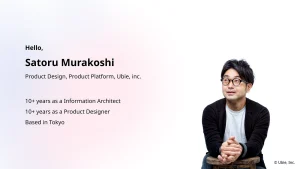
Hello, I’m Satoru Murakoshi (@smurakos) from Ubie Inc., a healthcare platform provider with the mission of “guiding people to appropriate medical care through technology.” I have over 10 years of experience as an information architect and product designer based in Tokyo. Today, I am going to talk about Ubie’s patient-centric design under the theme “Designing the Future of Healthcare — Patient-Centric Design Approach in Healthcare Platforms.”
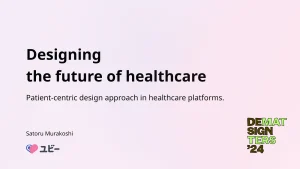
Company Introduction — Ubie
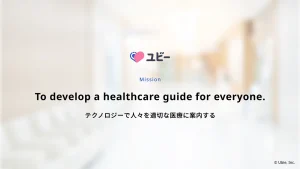
Ubie is a health tech startup founded in May 2017 by doctors and engineers with the mission of “To develop a healthcare guide for everyone.” With AI as its core technology, Ubie develops and provides products such as “AI-Powered Symptom Checker,” a symptom checker that guides users to appropriate medical care based on their symptoms, and “Ubie Medical Navi(only available for Japan),” a service package for medical institutions to improve the quality of care. Ubie aims to create a society where everyone can access healthcare.
Product Introduction — AI-Powered Symptom Checker
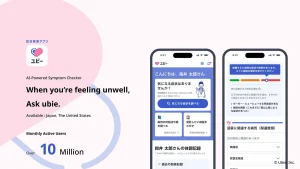
First, let me introduce Ubie’s product platform. The main product is the “AI-Powered Symptom Checker,” a symptom checker. Its purpose is to support people in finding appropriate medical care. From concerning symptoms, users can check related diseases and suitable medical facilities, promoting connections to proper healthcare. The product has grown steadily, surpassing 10 million MAUs as of May 2024.
It has also been used more than 2 million times in the US, and it aims for growth in Japan and worldwide.
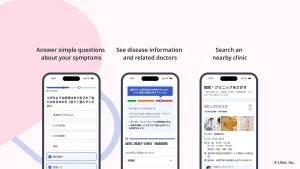
Let me also introduce how the AI-powered Symptom Checker works in detail. For example, when you’re not feeling well, you can use the AI-powered Symptom Checker to “answer a few questions,” “check a list of related illnesses and medical institutions,” and “find nearby medical institutions.”
Product Introduction — Ubie Disease Q&A
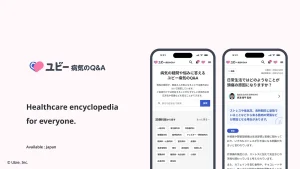
Ubie also offers another product called “Ubie Disease Q&A.” This is a media website where people can look up information about diseases, symptoms, medications, and more. We regularly expand the content to address various “things that the users want to know.”
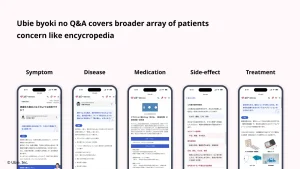
For example:
- Wanting to know the cause of symptoms
- Wanting to know details about a disease
- Seeking information about medications
- Seeking information about side effects
- Seeking information about treatment methods
We aim to provide a proper entrance for a broad array of user concerns, becoming the gateway to all medical information.
Overview- Our patient-centric design approach
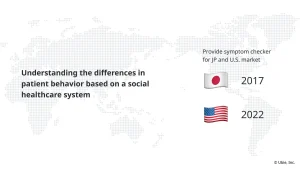
Now, let’s share the topic I want to discuss today, Ubie’s Patient-Centric Design Approach, with some case studies.
First, let’s briefly touch on the healthcare systems in Japan and the U.S.
Ubie currently offers products in both countries.
Then, let’s look at the differences between them.
Patients’ Healthcare behavior in Japan
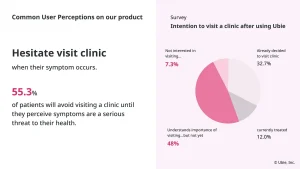
This shows the common healthcare behavior of Ubie users in Japan. According to a survey conducted within the Ubie product, many people — around 55% — tend to hesitate to visit the hospital until their symptoms become severe. Despite Japan having universal health coverage, people are reluctant to spend money on healthcare unless they deem it necessary. They tend to think, “I’ll go when it becomes necessary…” and don’t act unless they perceive it as a threat.
Patients’ Healthcare behavior in the U.S.
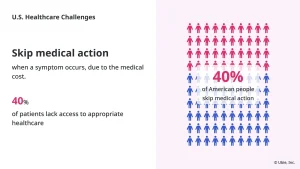
Let’s also briefly look at the U.S. As you may know, one of the major issues in the U.S. is the high cost of healthcare. More than 40% of people tend to avoid going to the hospital due to medical costs, even when they have symptoms. The balance between cost and healthcare outcomes in the U.S. social healthcare system is quite poor, causing many people to hesitate to access medical services.
Common Patient’s pain point
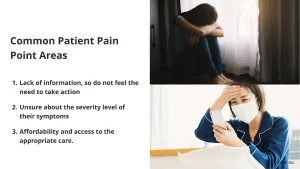
From the situations in both countries, we can find several common patients pain points:
- Issues of Information: Appropriate medical information is not being provided to the patients, not encouraging them to seek necessary medical care.
- Unsure whether the patient’s symptoms are serious.
- Affordability and Cost: Especially in the U.S., medical services are not provided at appropriate costs, making access to healthcare poor.
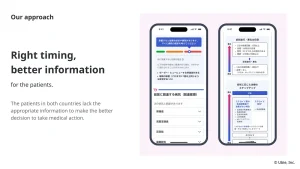
The key point in these healthcare issues is “ optimizing medical outcomes.” Therefore, Ubie’s basic approach is to “provide better information at the right time.” In both Japan and the U.S., people often do not have the appropriate information when they are about to take medical action. Ubie optimizes medical outcomes and connects people to appropriate healthcare by providing suitable information when people need it.
Fundamental Attitude on Patient-Centric Design
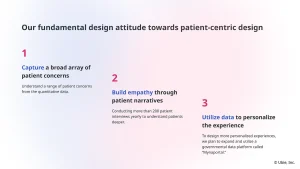
Ubie considers the following three points as the basic stance for conducting Patient-Centric Design in healthcare platforms:
- Capture and comprehend the broader concerns and interests of the public through quantitative data analysis.
- Deeply understand the patient journey through qualitative research.
- Utilize government databases.
Case Study 1: Connecting Asthma Patients to Appropriate Medical Care

Here, I’d like to share one case study. The basic understanding is that many asthma patients tend to continue the same treatment even when their symptoms worsen.

Let me ask one big question: “Why do patients tend to continue the same treatment even when their symptoms worsen?” To understand this question, we first researched patients.

Before the research, we set up starter questions according to the How Might We framework: “How might we ensure that patients with severe asthma understand the seriousness of their condition and feel encouraged to adjust their treatment?”
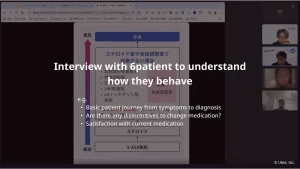
This time, we conducted in-depth interviews with 6 people to understand asthma patients better. In the interviews, we wanted to learn:
- The basic patient journey from symptom occurs to actual diagnosis.
- Whether there is a psychological barrier to changing treatments.
- Satisfaction with the current treatment.

From the interviews, we found significant issues within the basic patient journey, especially in the treatment phase.
- Many asthma patients are unsure how severe their symptoms are.
- The patients are also unsure of the appropriate timing to change treatments.
- That’s why that Patients tend to continue the same treatment in a rambling.
Based on these key findings, we improved the content of the symptom checker product.
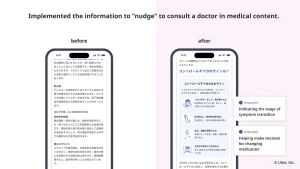
We enhanced this by incorporating information that encouraged consultations with doctors based on interview findings. In the improved version, we included:
- Provide detailed descriptions of symptom transition.
- Provide decision criteria for treatment changes.
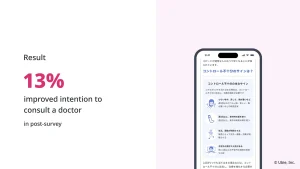
As a result, a post-survey comparison showed that the number of people who wanted to consult a doctor about their treatment increased by about 13%, promoting action towards considering treatment changes.
This case demonstrates the importance of deeply understanding the patient’s journey to deliver appropriate information to patients.
Case Study 2: Providing Appropriate Medical Information to Asthma Patients Utilize Government Database Linkage
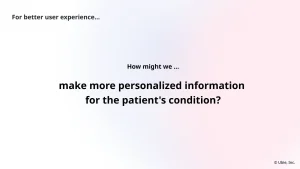
Second, we explore another question to create a better experience: “How might we provide more personalized information for the patient’s condition?”
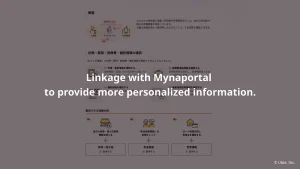
One initiative to achieve a personalized experience is Ubie’s challenge to design experiences through linkage with Japan’s government-run online portal, Mynaportal, aiming for “more personalized information provision.”
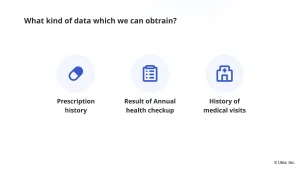
Data that can be obtained from Mynaportal Portal includes:
- Prescription history data
- History of Annual health check-up results
- History of medical visits
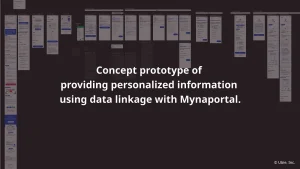
We are exploring creating a more personalized experience by using these data and patient input in the symptom checker.

To explore the possibilities of this experience, we decided to test personalized experiences through concept prototypes.
We focused on asthma and defined a model persona initially:
- Female in 40s
- She has been on the same treatment for about 5 years
- She is used to living with her symptoms but occasionally experiences attacks or sleepless nights
- She is often told to “wait and see, “ even when she tells her doctor.”
- She is wondering whether she should continue the same treatment.
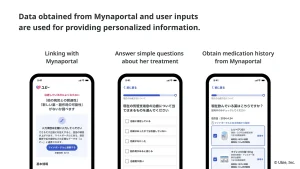
Design an experience that assumes this persona will be connected to the appropriate treatment when using the concept prototype.
The conceptual experience is as follows: In addition to patient input on symptoms in the symptom checker, by linking Mynaportal with Ubie, we obtain prescription data and provide personalized information on asthma treatment.

By visualizing the current treatment situation based on the patient’s symptoms and utilizing drug information linked from Mynaportal, we present information tailored to their situation regarding the types and steps of treatment. This encourages those treating asthma to understand whether their current treatment is appropriate and consider better treatment options.
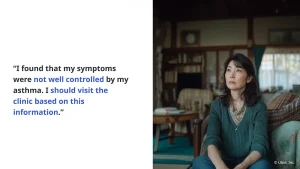
The ideal experience we wanted to provide through this concept is that “realizing that they cannot manage their asthma symptoms well, they feel motivated to visit a clinic based on this information,” leading them to take actual action.

Through this concept, we aim to combine data obtained from Mynaportal with patient input to provide transparency, allowing patients to recognize risks they hadn’t noticed. Although this is still a concept, we aim to realize such “personalized experiences” for patients in the near future.
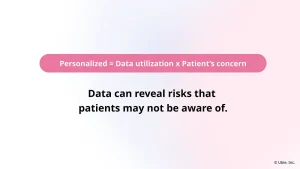
Achieving a personalized experience is maintaining a balance between “data utilization” and “understanding patients’ concerns and worries.” Listening to and inputting patients’ concerns and worries in detail and balancing the quantity and quality of historical data obtained from sources like Mynaportal is crucial. When this balance is well-maintained, data can present risks to patients that they hadn’t noticed.
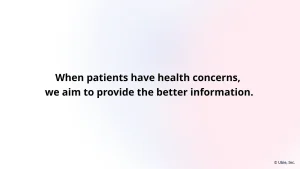
The essence behind the patient-centric design approach is very simple: providing better information when patients face health concerns. We always strive to offer better information about patients’ worries and concerns through quantitative data, qualitative research, and external data integration.
Conclusion- Ubie’s Patient-Centric Design Approach
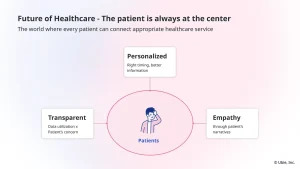
Always thinking from the patient’s perspective. Ubie aims to create a world where all patients can access appropriate healthcare. In this presentation, we introduced the following three perspectives of our Patient-Centric Design approach:
- Personalization: Providing better information at the right time.
- Empathy: Deep understanding of the patient journey through dialogue with patients.
- Transparency: Understanding patients’ conditions through quantitative data and external data integration.
Attitude Towards Facing Patients

To conclude this presentation, I’d like to share my attitude when facing patients. By empathizing with the patient journey, we aim to maximize their long-term outcomes. When confronting with the patients, there is a life and emotions behind each one. Even as the platform scales, I, as a product designer, want to continue listening to each patient’s worries and concerns. That is my design attitude.
Extending the Healthy Life Expectancy of 8 Billion People Worldwide

Finally, I’d like to share the future we aspire to: Extending the healthy lifespan of 8 billion people worldwide.
References
Ubie Checkup for AsthmaUbie Checkup for Asthma. Your Words, Now in Doctor’s Terms!ubiehealth.com
***
Satoru gave a talk at Design Matters Tokyo 24. If you want to check out his talk, make sure to take a look here.
In 2024 Design Matters turns 10! Celebrate and take part in this special 3-day event, which will take place both online and in Copenhagen, on October 23-24-25, 2024. Read more about the discounts and get your ticket here.




